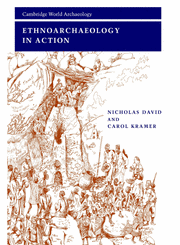Book contents
- Frontmatter
- Dedication
- Contents
- List of figures and credits
- List of tables
- Preface
- Acknowledgments
- Map
- 1 Ethnoarchaeology: its nature, origins, and history
- 2 Theorizing ethnoarchaeology and analogy
- 3 Fieldwork and ethics
- 4 Human residues: entering the archaeological context
- 5 Fauna and subsistence
- 6 Studying artifacts: functions, operating sequences, taxonomy
- 7 Style and the marking of boundaries: contrasting regional studies
- 8 Settlement: systems and patterns
- 9 Site structures and activities
- 10 Architecture
- 11 Specialist craft production and apprenticeship
- 12 Trade and exchange
- 13 Mortuary practices, status, ideology, and systems of thought
- 14 Conclusions: ethnoarchaeology in context
- Bibliography
- Index
4 - Human residues: entering the archaeological context
Published online by Cambridge University Press: 05 March 2015
- Frontmatter
- Dedication
- Contents
- List of figures and credits
- List of tables
- Preface
- Acknowledgments
- Map
- 1 Ethnoarchaeology: its nature, origins, and history
- 2 Theorizing ethnoarchaeology and analogy
- 3 Fieldwork and ethics
- 4 Human residues: entering the archaeological context
- 5 Fauna and subsistence
- 6 Studying artifacts: functions, operating sequences, taxonomy
- 7 Style and the marking of boundaries: contrasting regional studies
- 8 Settlement: systems and patterns
- 9 Site structures and activities
- 10 Architecture
- 11 Specialist craft production and apprenticeship
- 12 Trade and exchange
- 13 Mortuary practices, status, ideology, and systems of thought
- 14 Conclusions: ethnoarchaeology in context
- Bibliography
- Index
Summary
If … by observing the adaptive behavior of any living society, we can derive predictions about that society's discards, we are doing living archaeology.
(Richard Gould 1980: 112)Household no. 1 collected their domestic refuse, including tin cans, in a large duffel bag which was later transported by canoe to a lake about 19 km from the residential camp.
(Robert Janes 1983: 32).We start the chapter by introducing relevant concepts and ideas of middle range theory, especially those concerned with processes relating to the transfer of materials from the systemic to the archaeological context (S–A processes). We then survey their application to deposits and sites and consider the effects of processes such as curation on the archaeological record. A processual and a postprocessual case study relating to residues are presented and critiqued, and the chapter concludes with a consideration of the ethnoarchaeology of abandonment.
Middle range theory from S to A
Some regard “the reconstruction of prehistoric lifeways in the form of prehistoric ethnographies to be an appropriate goal for archaeology,” while others consider rather “that we should be seeking to understand cultural systems, in terms of organizational properties,” as Binford (1981b: 197) argued in his “Pompeii premise” paper. Many take an intermediate view:
To analyze archaeological units without referring back to where they came from and to what they represent is to divest such units of most meaning.
- Type
- Chapter
- Information
- Ethnoarchaeology in Action , pp. 91 - 115Publisher: Cambridge University PressPrint publication year: 2001



